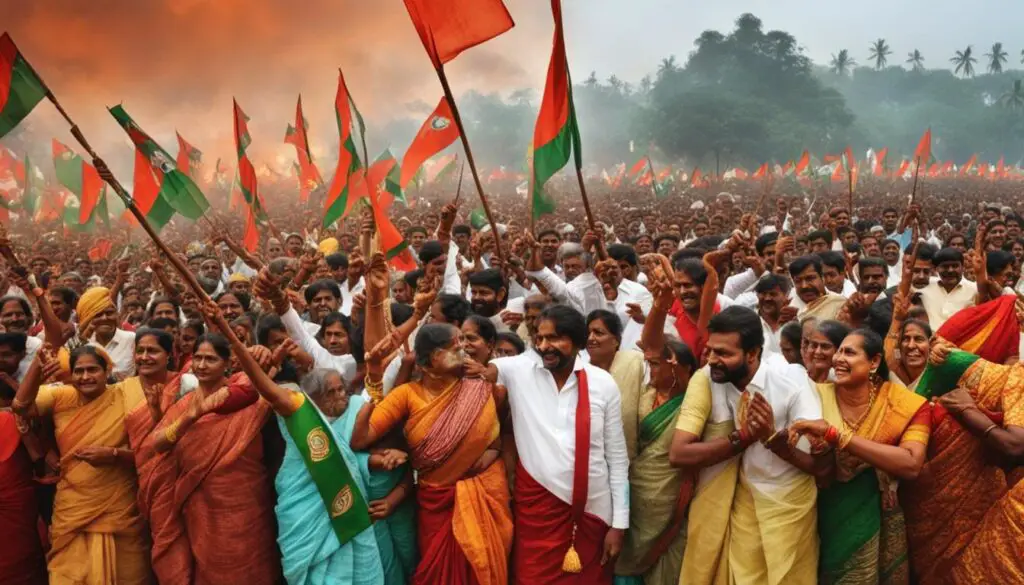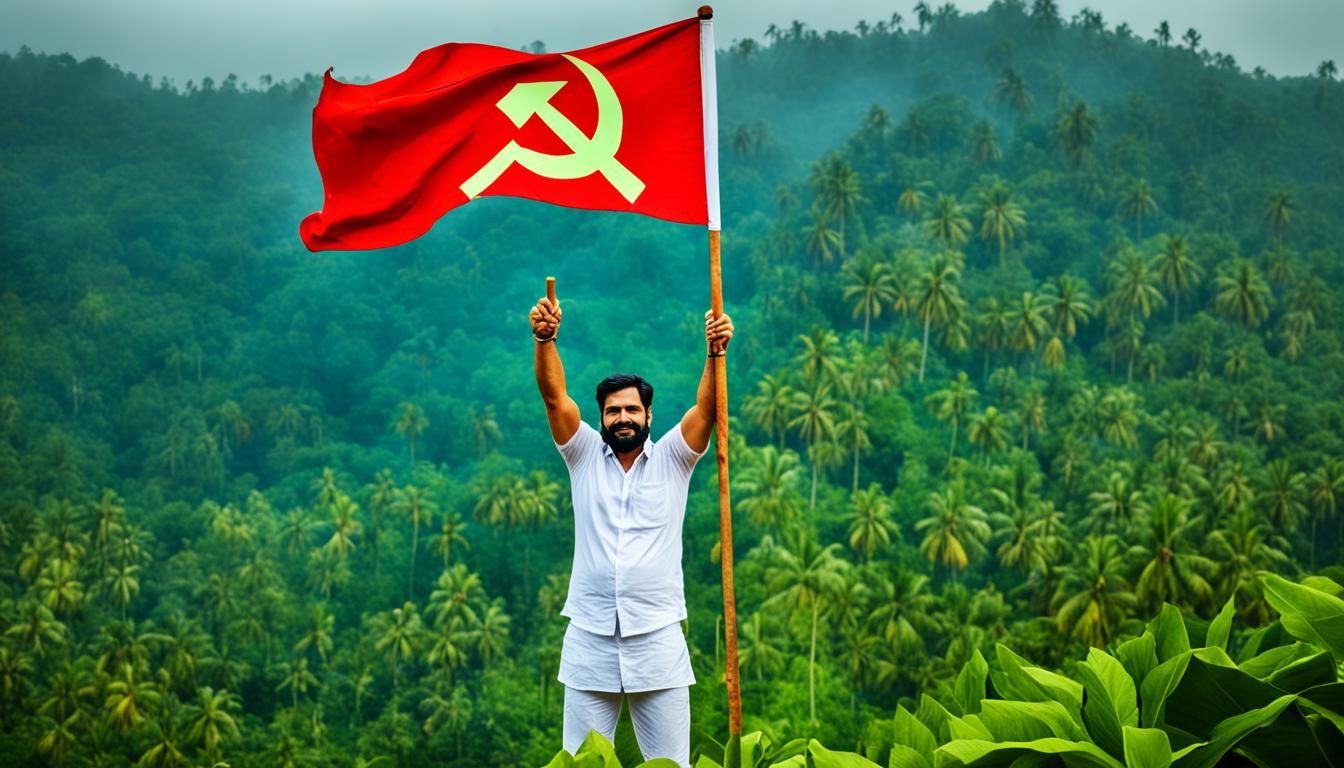The Kerala Communist movement has had a significant impact on the Indian state of Kerala, shaping its political landscape and social structure. Since the 1950s, the Communist Party has enjoyed a remarkable level of political dominance in the region, establishing a unique phenomenon known as “party villages.” These villages, particularly in the Kannur district, serve as strongholds for the Communist Party and hold immense influence over the local population.
Despite the Communist Party’s ideology that opposes feudalism, caste hierarchy, and imperialism, party villages coexist with the existing Hindu caste structures. This paradox highlights the party’s ability to adapt to regressive caste hierarchies while upholding its revolutionary ideals. Understanding the mechanisms through which the Communist Party sustains its dominance in these party villages is crucial to comprehending the complexity and enduring influence of the Kerala Communist movement.
Key Takeaways:
- The Kerala Communist movement has enjoyed sustained political dominance in the state since the 1950s.
- “Party villages,” concentrated in the Kannur district, serve as strongholds for the Communist Party.
- Party villages coexist with Hindu caste structures, showcasing the party’s adaptability.
- Analyzing the Communist Party’s grassroots dominance in party villages provides insights into its enduring influence.
- The Kerala Communist movement’s impact extends beyond politics and affects people’s lived experiences.
The Historical and Political Context of Kerala Politics
To understand the impact of the Kerala Communist movement, it is essential to delve into the historical and political context of Kerala politics. The Communist Party’s ascendancy in the region dates back to the 1950s when the state of Kerala was formed after Indian independence in 1947. In the subsequent years, Kerala witnessed a unique phenomenon where Communists were elected to power through democratic elections in 1957, making it a significant case in Indian political history.
Kerala politics is deeply influenced by social structures and caste groupings that shape the political landscape. The state’s villages, such as Che Puram, exhibit distinct caste divisions, resulting in social cleavages and political allegiances. Caste structures play a significant role in defining the power dynamics in Kerala, with parties often relying on segmental cleavages, such as caste, to mobilize electoral support.
The social structure of Kerala’s villages also reflects the distribution of resources, including average land holdings, within distinct caste groupings. This distribution further influences political allegiances and voting patterns in the region. Understanding the interplay between the Communist Party, caste hierarchies, and political allegiances is crucial to comprehending the enduring influence of the Kerala Communist movement.

The Role of Caste in Kerala Politics
In Kerala, caste plays a significant role in shaping political dynamics and alliances. The caste system, deeply rooted in the social fabric, influences individual identities and societal structures. Despite the Communist Party’s efforts to challenge caste hierarchies, the influence of Hindu religion and caste structures continues to persist.
The Communist Party, while striving for equality, has also recognized the need to adapt to existing caste hierarchies within party villages, ensuring its political dominance.
Thus, the Kerala Communist movement navigates a delicate paradox, simultaneously challenging and adapting to caste hierarchies to maintain its political stronghold. The complexities and contradictions presented by the party village dynamic shed light on the challenges faced by revolutionary movements in upholding their principles while in power.
| Political Landscape Factors | Continued Influence |
|---|---|
| Caste Divisions | Shape political allegiances and mobilization strategies. |
| Social Cleavages | Influence voting patterns and electoral outcomes. |
| Resource Distribution | Correlates with distinct caste groupings and affects political power. |
The Kerala Communist movement’s enduring influence can be understood by unraveling the intricate connections between the Communist Party, Kerala politics, social structure, caste groupings, and political allegiances. This analysis provides insights into the complexity of the movement and its impact on regional politics.
The Paradox of Caste Hierarchy in Party Villages
The paradox of continued caste hierarchies in party villages is a crucial aspect of the Kerala Communist movement. Despite the Communist Party’s ideology promoting equality and challenging caste hierarchies, the influence of Hindu religion and caste structures continues to shape individual identities and social settings in party villages.
Hindu customs and practices related to festival celebrations, marriage choices, and cremation decisions still hold significance, even in villages dominated by the Communist Party. This party village paradox highlights the complexity of the Kerala Communist movement, as it adapts to regressive caste hierarchies while simultaneously claiming to challenge them.
The Communist Party’s ability to maintain its political dominance in these villages lies in its strategic navigation of caste structures. By acknowledging and accommodating the existing social systems, the party secures support from various caste groups while advancing its revolutionary ideals. This delicate balance ensures the party’s grassroots dominance and enables the Kerala Communist movement’s enduring influence on regional politics.
FAQ
What is the Kerala Communist movement?
The Kerala Communist movement refers to the political dominance and electoral success of the Communist Party in the Indian state of Kerala since the 1950s.
What are party villages?
Party villages are areas in Kerala, primarily in the Kannur district, where the Communist Party holds significant power and influence beyond being political strongholds.
How does the Communist Party coexist with caste hierarchies in party villages?
Despite the Communist Party’s anti-caste ideology, party villages in Kerala maintain regressive caste hierarchies, showcasing the party’s ability to adapt while upholding its revolutionary ideals.
What is the historical and political context of Kerala politics?
The Communist Party’s ascendancy in Kerala dates back to the 1950s when the state was formed after Indian independence. Kerala’s politics are shaped by caste divisions and social cleavages.
How do caste hierarchies shape political allegiances in Kerala?
Kerala’s villages have distinct caste groupings that influence political allegiances and resources allocation, such as average land holdings. These caste structures play a significant role in Kerala’s political landscape.
Why do party villages in Kerala maintain caste hierarchies despite the Communist Party’s ideology?
Hindu customs and practices related to festivals, marriages, and cremations continue to hold significance in party villages, reflecting the influence of Hindu religion and caste structures.
How does the Communist Party maintain its grassroots dominance in party villages?
The Communist Party adapts to regressive caste hierarchies in party villages while maintaining political dominance, striking a balance between sustaining its principles and upholding its revolutionary ideals.
